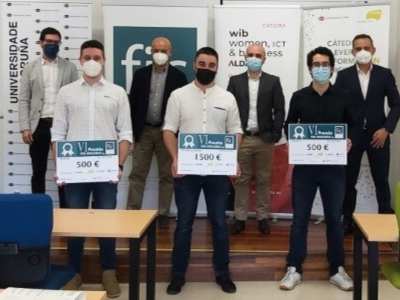The event was held online on April 9, 2021. This award recognizes the best final degree projects submitted and defended during the 2019/2020 academic year by students of the Faculty of Computer Science at the University of A Coruña. This sixth edition of the Award was sponsored by the companies Imatia Innovación, Inycom, Everis, and Aldaba. The best final degree projects defended during the 2019/2020 academic year were recognized, with Noé Vila Muñoz taking First Prize, valued at €1,500. The runners-up prizes, each worth €500, were awarded to Andrés Molares Ulloa and Bieito Beceiro Fernández.
In addition, the works of Francisco Bretal Ageitos and Diego Suárez García were named finalists. Although they didn’t win any awards, they submitted high-quality work.
Noé Vila Muñoz won First Prize for Best Applied Final Degree Project at the FIC with the project: Mobile application for carrying out and tracking routines in children with ASD. The objective of this bachelor’s thesis is to develop a cross-platform mobile application for the Android and iOS operating systems that guides and assists children with autism spectrum disorder in carrying out daily routines and tasks, thereby granting them greater autonomy and enabling their educators to schedule and monitor these routines and tasks.
Bieito Beceiro Fernández was awarded one of the two Accésit prizes for the work: "Parallel-FST:" Accelerating Feature Selection Algorithms Using Parallel Computing. Currently, there is a surge in the production and consumption of large amounts of information (big data), which must be processed and prepared for subsequent use. Among the tools used to analyze these data are those of machine learning, which constitutes another field of research that has gained importance in recent years. For this type of study, it is often necessary to develop libraries containing the feature selection methods to be studied, so that the results can be compared. This is the case with FEAST, a library that includes eight feature selection methods based on mutual information. In this work, FEAST was optimized using parallel techniques, adapting its methods to run on and take advantage of HPC systems. In this way, we were able, on the one hand, to reduce computation time; and on the other, to enable the analysis of large datasets that exceed the memory limitations of conventional systems.
Andrés Molares Ulloa was awarded one of the two Accésit prizes for his work: “System for advising on preventive closures in the Vigo estuary due to lipophilic biotoxins.” Harmful algal blooms are episodes of high concentrations of algae that are potentially toxic for human consumption, since the toxins they produce would be ingested thru the consumption of filter-feeding mollusks such as mussels. In Galicia, the body responsible for monitoring mussel production areas for potential biotoxin contamination is INTECMAR (Instituto Tecnolóxico para o Control do Medio Mariño de Galicia). This work aims to develop an application that supports decision-making when implementing preventive closures on days when prior sampling has not been possible.
Francisco Bretal Ageitos, finalist for the work: "Platform for managing phytoplankton sample labeling projects." Currently, experts in the field of biology are responsible for analyzing multiple water mass samples to ensure their potability. All of this work is done manually due to the lack of suitable state-of-the-art alternatives. It was necessary to develop a new platform designed to provide a way to centralize all of this work. The platform’s mission is to provide carefully designed tools tailored to the identification process, while freeing scientists from some of their workload.
Diego Suárez García, finalist for the work: "Tool for evaluating damage to centolla sperm DNA thru comet cell analysis." Since the late 20th century, experts have used the comet assay to study DNA damage. Their study is important because it provides information on which external physical and chemical agents can damage its structure. This project consists of developing a tool that meets your needs. The proposed solution is based on the detection and segmentation of DNA in images using automatic image processing algorithms that analyze image histograms, and on integrating this methodology into a tool that also enables simple and efficient manual image segmentation.



